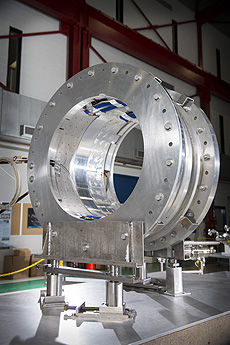Prototype of Mu2e solenoid passes tests with flying colors
 |
This prototype represents one of 27 modules that will make up a critical section of the Mu2e experiment, the transport solenoid. Photo: Reidar Hahn |
If you've ever looked at a graphic of Fermilab's future Mu2e experiment, you've likely noticed its distinctive, center s-shaped section. Tall and wide enough for a person to fit inside it, this large, curving series of magnets, called the transport solenoid, is perhaps the experiment's most technologically demanding piece to build.
Last month a group in the Fermilab Technical Division aced three tests — for alignment, current and temperature — of a prototype transport solenoid module built by magnet experts at Fermilab's Technical Division and INFN-Genoa in Italy.
The triple milestone means that Fermilab can now order the full set for production — 27 modules.
"The results were excellent," said Magnet Systems Department scientist Mau Lopes, who is leading the effort.
There's not much wiggle room when it comes to the transport solenoid, a crucial component for the ultrasensitive Mu2e experiment. Mu2e will look for a predicted but never observed phenomenon, the conversion of a muon into its much lighter, more familiar cousin, the electron, without the usual accompanying neutrinos. To do this, it will send muons into a detector where scientists will look for particular signatures of the rare process.
The transport solenoid generates a magnetic field that deftly separates muons based on their momentum and charge and directs slow muons to the center of the Mu2e detector. The maneuver requires some fairly precisely designed details, not the least of which is a good fit.
When put together, the 27 wedge-shaped modules will form a tube with the snake-like profile. Muons will travel down this vacuum tube. To guide them along the right path to the detector, the solenoid units must align with each other to within 0.2 degrees. The Magnet Systems team exceeded expectation: The prototype was aligned with 100 times greater precision.
The team achieved not just the right shape, but the right current. The electrical current running through the solenoid coil creates the magnetic field. The Mu2e team exceeded the nominal current of 1,730 amps, reaching 2,200 amps. As a bonus, while that amount of current has the potential to create a slight deformation in the module's shape, the Mu2e team measured no change in the structure.
Nor was there much change in the model's temperature, which must be very low. The team delivered 2.5 watts of power to the coil — well above what the coils will see when running. The module proved robust: The temperature changed by a mere whisker — 150 millikelvin, or 0.27 degrees Fahrenheit. The coils will be at 5 Kelvin when operating. The prototype sustained the nominal current at up to 8 Kelvin.
Fermilab has selected a vendor to produce the modules. Lopes expects that it will be two and a half years until all modules are complete.
"We thank all the smart people at INFN Genoa, the Fermilab Test and Instrumentation Department, the Magnet Systems Department and the Accelerator Division Cryogenics Department for this achievement," Lopes said. "These seven months of hard work have paid off tremendously. Our project continues at full steam ahead."
—Leah Hesla
|